Gentlemen,
The past year has been a quiet one. We've commissioned 2 BBs, 2 CLs and 2 DDEs, and laid down a new battleship and a pair of CAs, while our adversaries have continued their building programs, but the world situation remains calm.
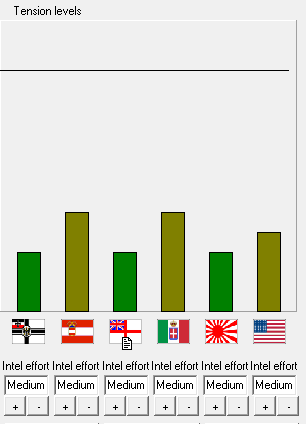
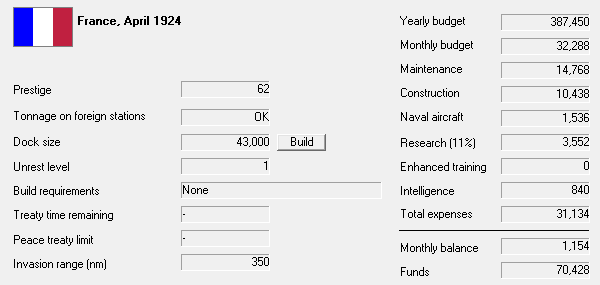
Our building program is largely set for the next year and more, but we do have some budget surplus right now, and CL Lalande's commissioning will give us more. We could probably squeeze in a third CA, or a CL or two, depending on where we deploy our budget. Unfortunatley, there has been little progress in aviation recently, except for the development of a new flying boat.



Our current fleet

Ships under construction

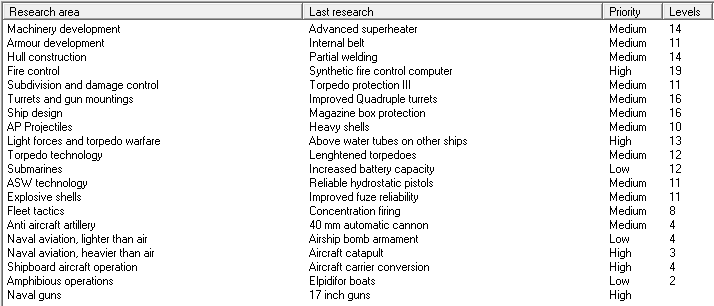
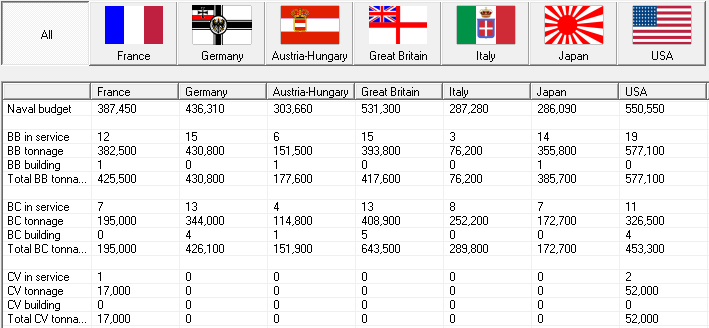
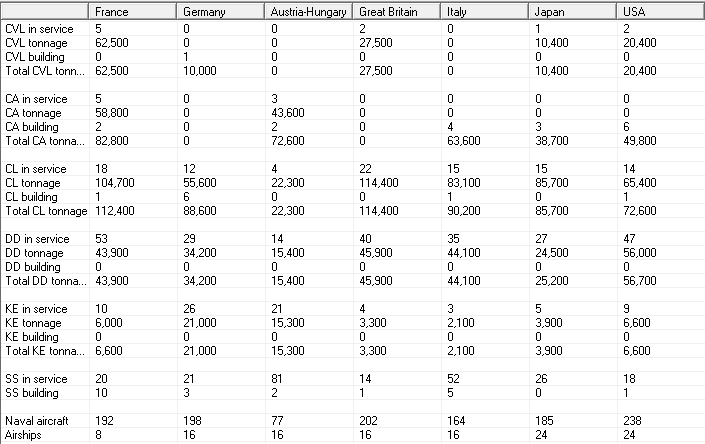
April 1923
Design work begins on BB Marengo and DDE Fauconneau. Germany lays down a CL, Italy commissions 4 DD, Japan 1 AV, US 1 CVL, 1 DD. DDEs Fauconneau and Hallebarde laid down.
May 1923
Carabiner class DDs begin refit. Breakthrough: Internal belt. We reject all three flying boat prototypes for being generally inferior to our existing D.60 Bs. Germany lays down an AV, UK commissions a CVL, US and Italy 2 DDs each.
June 1923
BB Republique commissions. US lays down a BC.
July 1923

Our spies steal plans for US CL Baltimore. Italy lays down a CL, AH a CA. Germany commissions an AV, Italy a DD.
August 1923

Design work begins on CA Latouche-Treville. Rebels in Guam defeat the US and declare independence. Our spies steal plans for German CL Medusa. BB Marengo is laid down. Germany lays down an AV, Italy a CA. Italy commissions 3 DD.
September 1923
BB Massena commissions. A second flying boat competition is started.
October 1923
November 1923
Great Britain crushes the Argentinian rebels in the Falklands. CAs Latouche-Treville and Pothau laid down. UK lays down a BC, commissions another, along with a CL. Italy also commissions a DD.
December 1923
UK lays down a BC, Italy a CA. Japan commissions 3 DD, US 1 BC.
January 1924
2 DD commission. Breakthroughs: Magazine box protection, Above water tubes on other ships. We buy the privately-developed Bloch MB.83 flying boat. Germany, AH and the US all lay down BCs. Italy and Japan each commission a DD.
February 1924
Our technology-sharing agreement with Britain expires. Germany lays down an AV, Japan commissions 3 DD.
March 1924

CLs Pluton and Coetlogon commission, and on trials, easily surpasses their design speed. Our spies steal blueprints for the US CA New York. Breakthrough: Increased battery capacity. US lays down 2 CA. AH commissions 1 BB, Japan 1 AV. B Solfinero is scrapped.
April 1925
Gentlemen,
International tensions have again begun to rise. Our failed expedition to Angola has put us at odds with Germany and Austria. This has boosted our budget, with the result that we were able to lay down 3 new CLs and 10 KEs, all either completed or about to be. The most important technological breakthrough we made was the development of larger destroyers, and we have a sketch of a new, 1,300 ton design we would like to pursue with our available budget. We should be able to lay down at least four immediately.
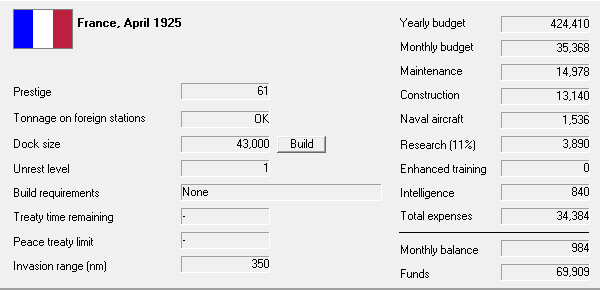
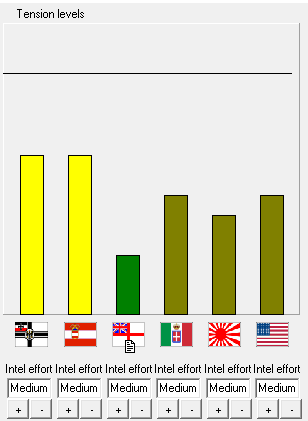
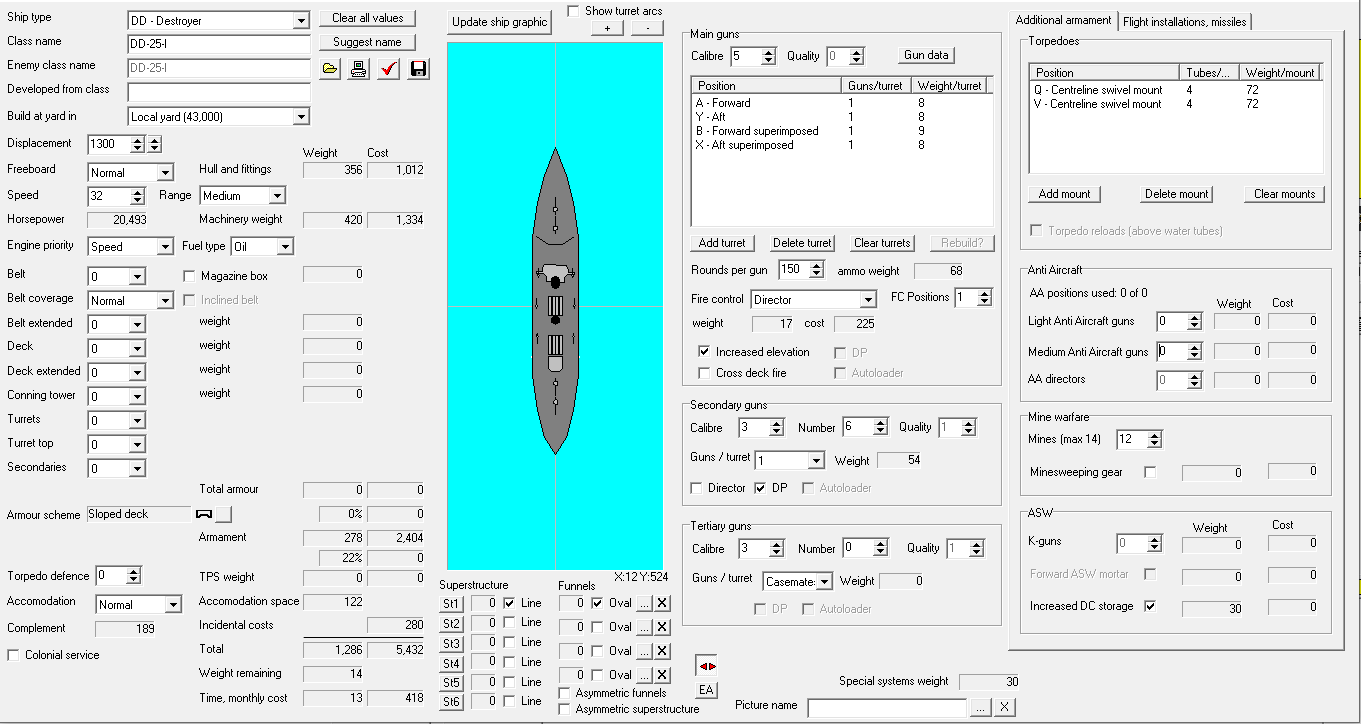
There's also the matter of our forthcoming ship completions. The end of 1925 and the beginning of 1926 will see us complete two CLs and two CAs, freeing enough funds to begin construction of another battleship. Given the possibility of war with Germany, this is probably not something we can afford to overlook. There's also been developments in aviation, as the British have allowed us to purchase their new medium bomber design, a type we do not have the technology to develop ourselves. How we wish to make use of this, and a general expansion in our land-based airpower, is up to you.
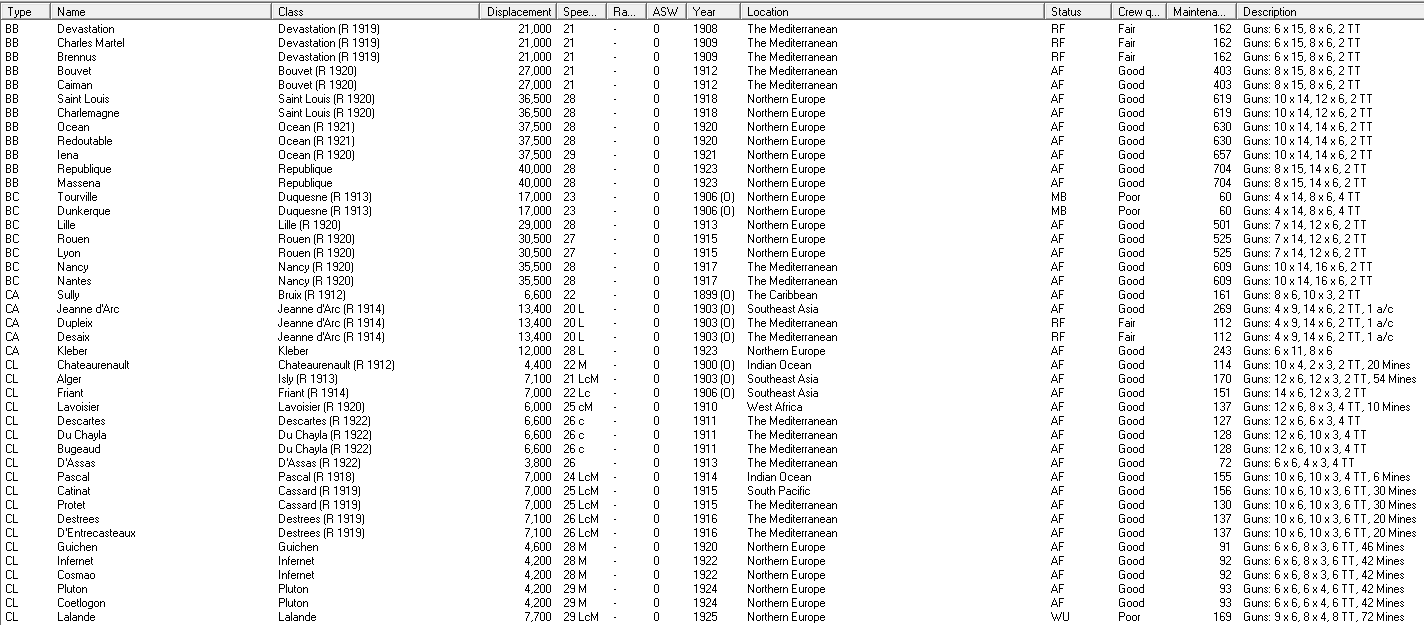


Our current fleet

Ships under construction
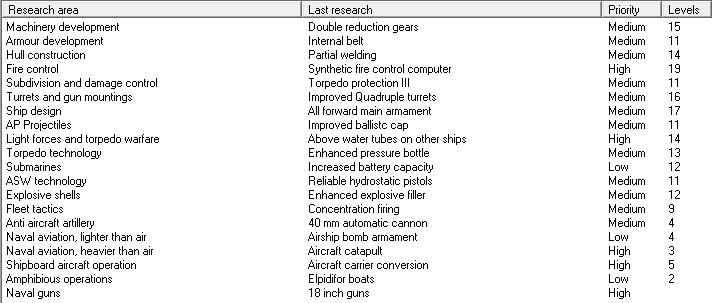
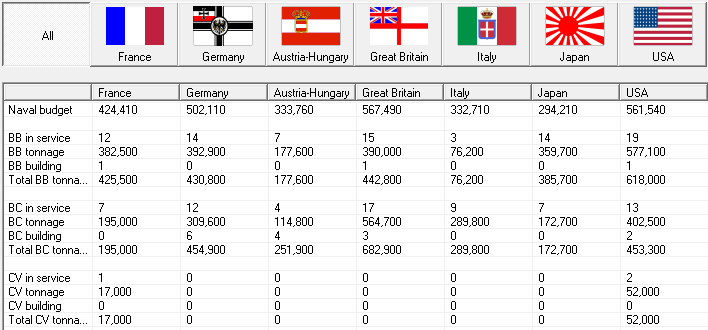
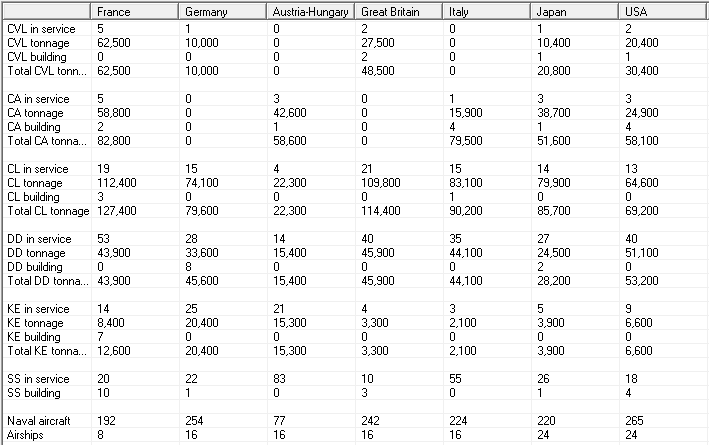

April 1924
Design work begins on CL Troude. Improvements in productivity help French industry. We buy Improved seaplane carrier from the Germans. 3 new KEs laid down. UK commissions 1 BC, Germany 1 CL.
May 1924
June 1924
Japan offers us a security alliance, but we turn them down. Breakthrough: Enhanced pressure bottle. UK lays down a BB, Germany commissions 1 CL, 1 CVL. AH commissions a CA, UK a BC.
July 1924
The spike in tensions increases our budget. We lay down CL Surcouf and 7 more KEs. We buy All forward main armament from the British. Breakthroughs: Double reduction gears, Enhanced explosive filler. 18"(-1) guns developed. UK lays down a CVL, Germany commissions AV, CL, Japan a CA.
August 1924
Japan lays down 2 DD. AH, Japan each commission 1 BB. Japan also commissions 1 AV.
September 1924
October 1924
Oil discovered in the Bismarcks. The Bloch MB.83 enters operational service. A new competition for floatplane scouts begins. Germany lays down 2 DD, Japan and the US 1 CA each. US commissions 1 BC.
November 1924
US lays down 1 CVL, Italy commissions 1 CA.
December 1924
Germany lays down 2 DD, Italy 1 BC. Germany commissions 1 CL, US commissions 1 CA, 1 CL.
January 1925
We attempt to take advantage of chaos in Angola to make it a protectorate, but the attempt goes wrong, spiking tensions. Germany lays down 1 DD, AH 1 BC, UK 1 BC. US commissions 1 BC, Japan 1 CA.
February 1925
CL Lalande commissions, along with 3 KEs. A German ship hits one of ours during a coronation review, and we blame them for the collision. Germany lays down 3 DD, UK and Japan 1 CL each. We buy the Vickers Cricklade medium bomber from the British. Design begins on CL Jurien de la Graviere (Troude development).
March 1925
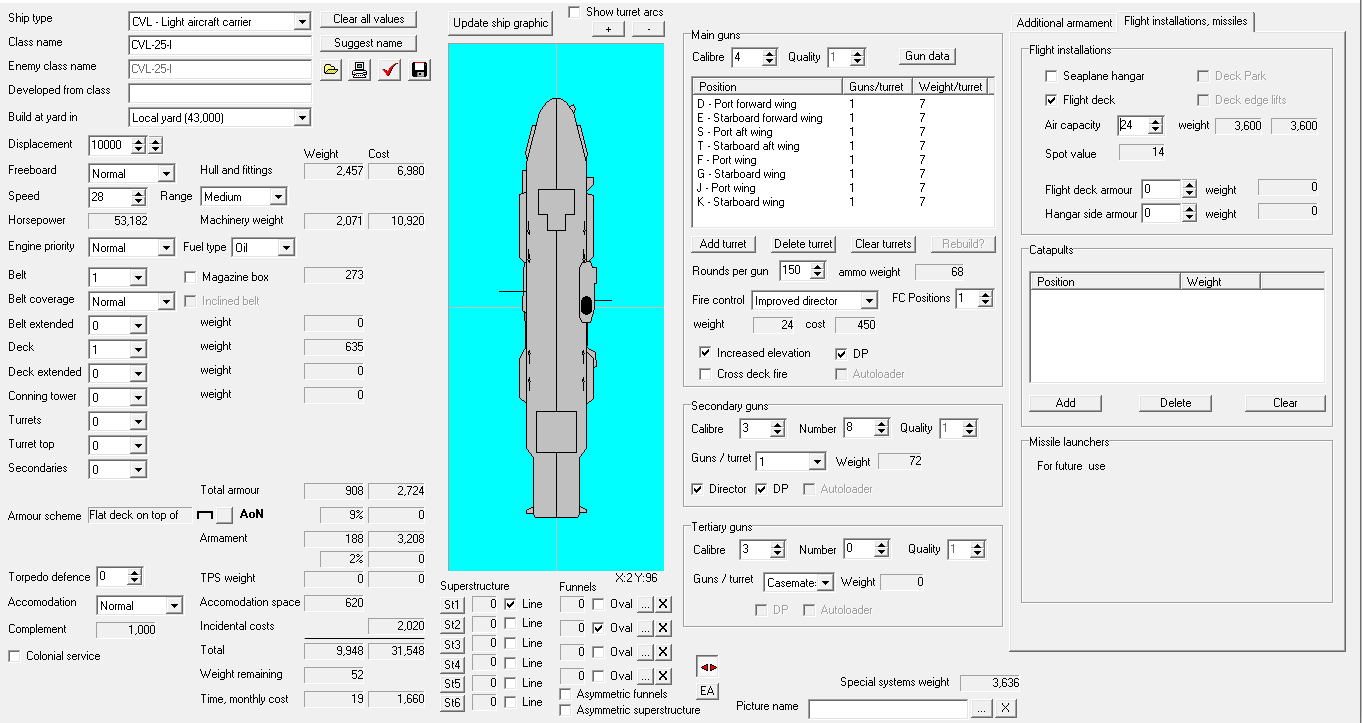
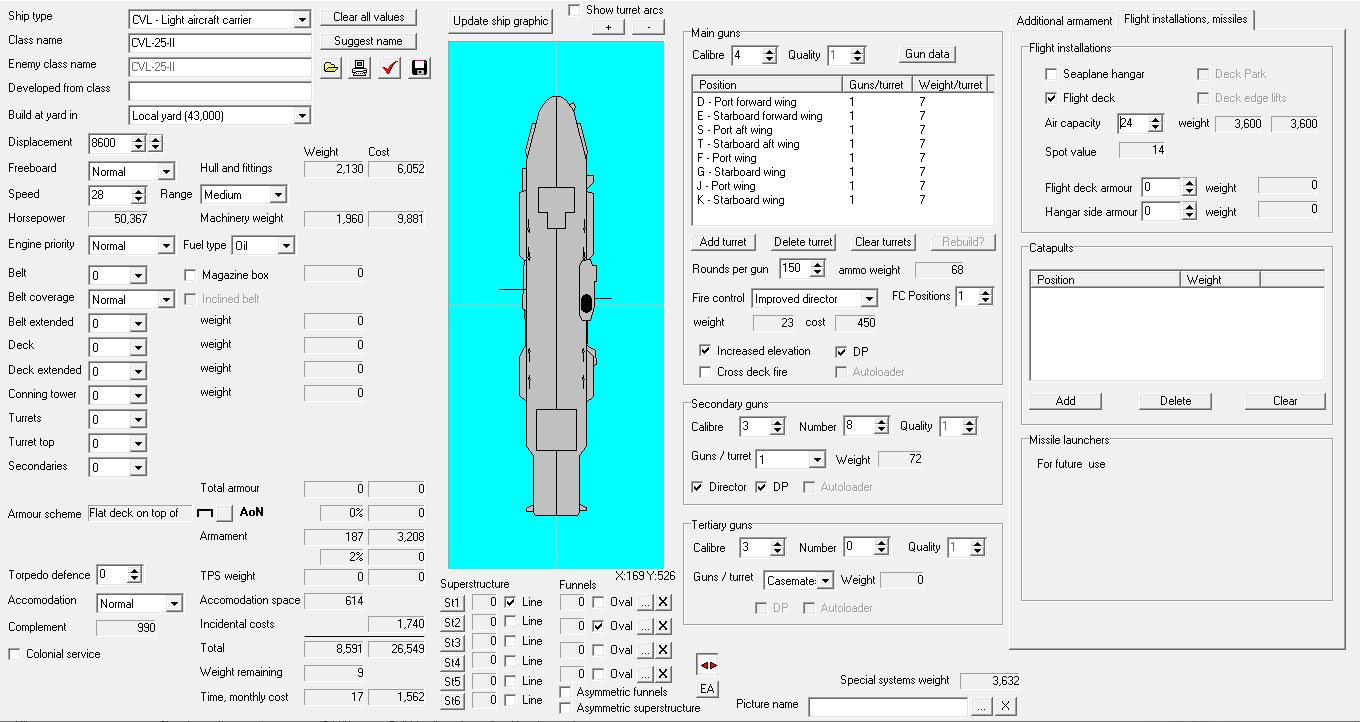
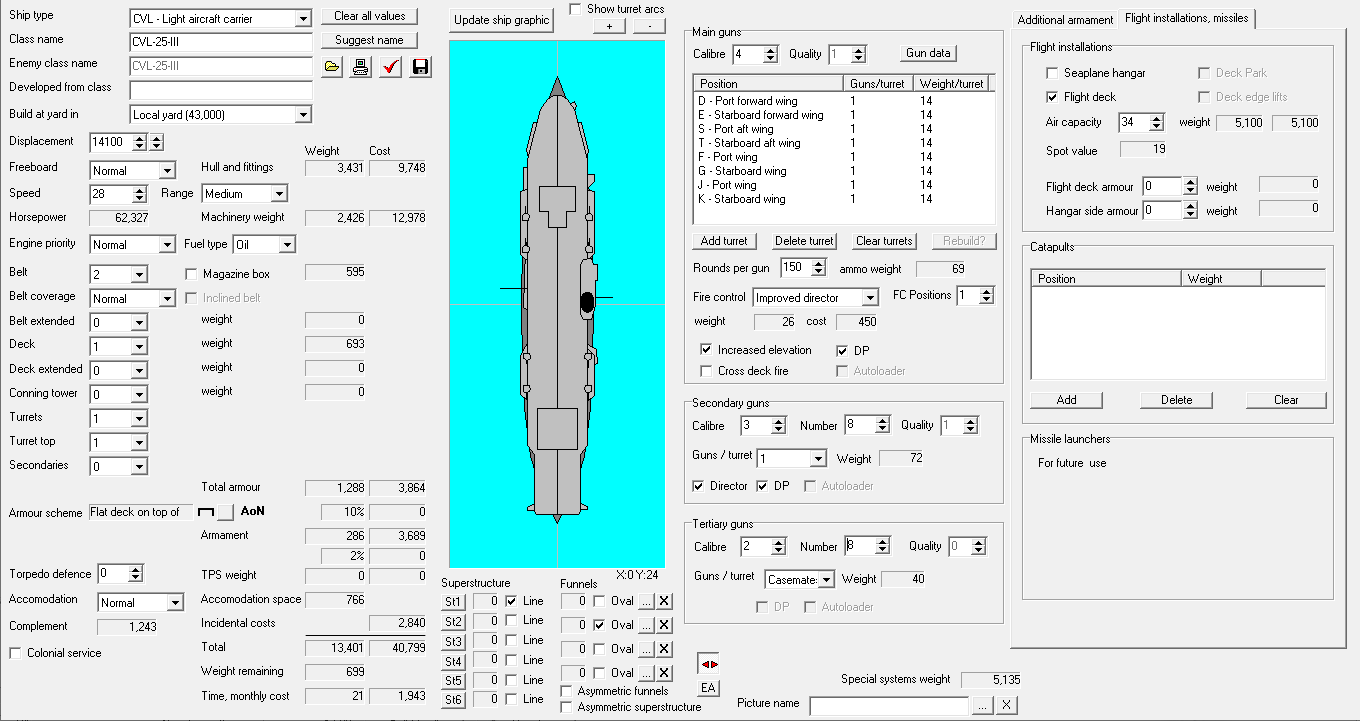
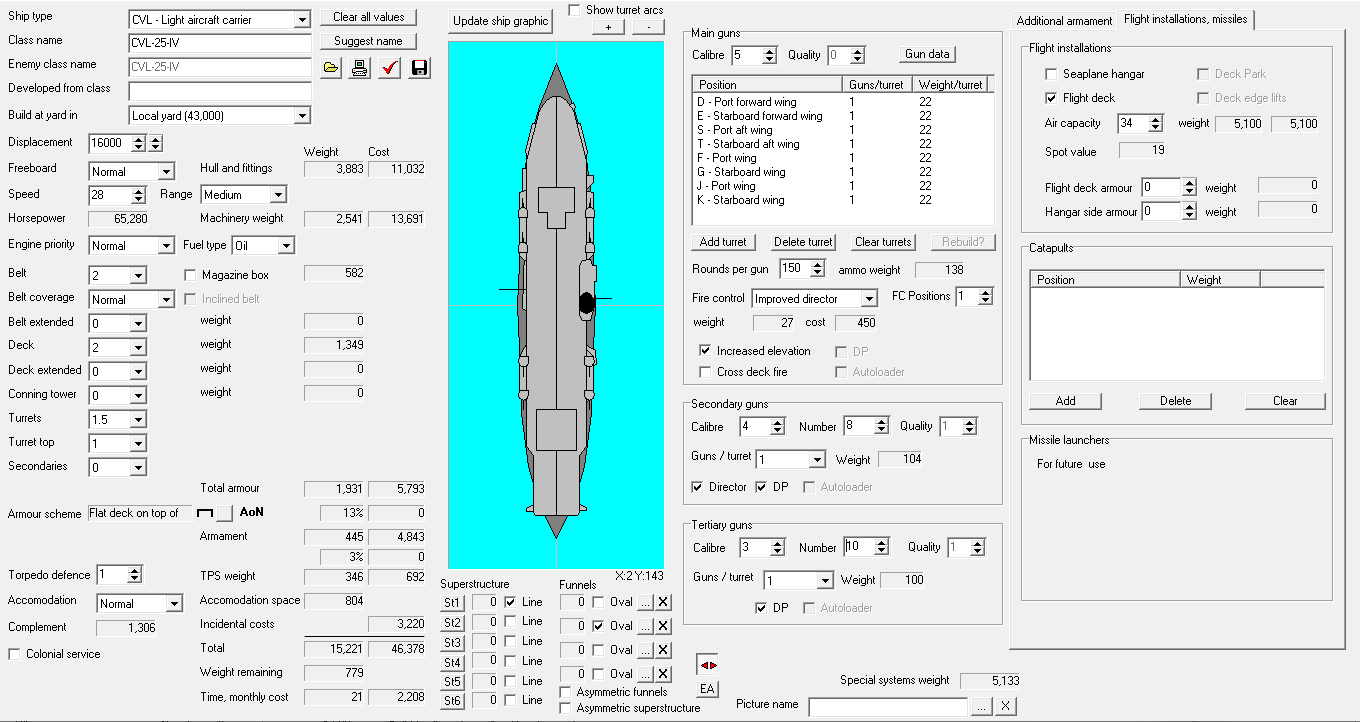

Comments
How fast can additional ASW assets be fielded at need? Italy and A-H seem to be building a LOT of subs.
We can build 400-ton ASW trawlers in 3 months during wartime. A 600-ton ASW KE would take 10 months at a cost of 155/month.
How would an ASW KE compare to the Fauconneau class DDs we've just built? 10 months at 155/month makes them about 3/5ths the cost, so if they can do the same job why not build them instead? Any hostile DDs we encounter in the Med will probably outmatch a Fauconneau, so they'll be used primarily as ASW escorts anyway. Hopefully we'll soon be able to build larger DDs for fleet work.
The three Jeanne d'Arc CAs could be converted to (ASW capable) CVLs like the Dupetit-Thouars were, and for much less than rebuilding Duquesne or a new carrier. That might be worth looking into. I'm not wholly against building a CVL from scratch either, since it won't be all that long before we are thinking about laying down fleet carriers, and actually having purpose built a carrier would give us useful experience.
There would also be value in an exercise involving multiple carriers to get some idea of the practicalities of coordinating strikes from several vessels. Our current carriers are too small to conduct a serious raid, but acting together they could put a reasonable number of aircraft over the target, and this will be knowledge that we can make better use of with larger carriers in future.
They'd have the same ASW capability by the numbers. Worse gunpower and no torpedoes, but probably a good trade given where we are. I'll draw up the plans.
Plan for play:
Lay down one 3-turret version of CL-23-V. Spend the rest of the budget surplus on 600-ton ASW KEs. Replace Lalande with a second CL, and more KEs.
I'm guessing that the second CL will be another three turret CL-23-V? There are a few of our oldest vessels that we could rebuild or scrap. It's probably not worth hanging on to the mothballed Duquesnes, due to the cost of converting them. They aren't too expensive to maintain, but why keep paying if we'll never modernise them? Other old ships that I might retire, include the Arquebuses, Chateaurenault and Bruix. Not sure how much that would save, but possibly enough to think about another KE (maybe a minesweeper to replace the Arquebuses).
Play was last night. Tension spikes gave us a bigger budget, so the total was 10 KEs and 3 CLs laid down. We're now yellow with Germany and Austria. The CLs were 3-turret CL-23-V designs. It probably is time to scrap the Duquesnes and Jeanne d'Arcs. They're too slow to be of much use these days. Likewise the remaining original ships (at least the ones that aren't recent conversions). We also got 1500-ton destroyers, although my best design is 1300 tons.
April 1925 is up.
I probably wouldn't get into medium/heavy bombers yet, but that's something to look into if an aircraft suitable for raiding the German ports becomes available.
Before we scrap the Jeanne d'Arcs, are we sure we don't want to convert them to CVLs?
Let's not get in a war with Germany and Austria without Britain on our side.
The new destroyer looks good, so let's build some as well as refitting the 1,100 ton DDs.
I'd be interested to see an all forward armament version of Marengo, as well as how the technology benefits our future CA designs.
The problem with the Jeanne d'Arcs is that they're too slow. Almost all of our fleet is 28 kts, and they're 20 kts. We'd probably be better-served by a 28-kt CVL with a full airgroup. I have a sketch of an 8,600 ton ship with 24 aircraft, 28 kts, and a cost of 1562/month for 17 months.
An all-forward Marengo saves about 500 tons, which is enough for an extra half-inch on the belt and turrets.
That is slow for a carrier, but then so are all our other aviation vessels. I imagine there may be some use for such ships in the Med to provide air cover to convoys, even after we have a proper fast CV fleet available. I think converting all three might be less than a new CVL though I expect the maintenance might drive the lifetime cost up. Treat them as escort carriers, though they may operate with the fleet for a few years until proper CVs are available. Of course, this is assuming that the game permits this - could we assign them to trade protection so they wouldn't show up for fleet engagements?
Good news about the all forward BB, are similar improvements in armour (or speed) be available for a CA?
We could look at assigning them to trade protection, although there's also something to be said for scrapping them and just saving the money. We already have 5 CVLs.
As for the CAs, a new Latouche-Treville has about 200 tons to play with, which is not quite enough for thicker belt or thicker deck.
Specifically, it reduces the weight of belt and deck armor, which can then be spent on other things. There's no explicit rule against any ship type using it, which makes it a valid (and IMO very good) choice for BBs, BCs, and CAs. It's a harder sell on CLs, which can have at most six barrels of dual-purpose all-forward main armament since triple and quad turrets can't be dual-purpose. Other ship types typically have little or no armor to reduce the weight of, and/or can't have centerline armament which implicitly means they can't qualify.
Our existing CLs 6" armament isn't DP, so that isn't a problem yet, but worth considering if we invest in some smaller CLs armed with 4" guns (or 5" when we have a good 5" DP gun). Are we interested in building an Atlanta style air defence cruiser?
Bean, you're probably right about scrapping the Jeanne d'Arcs - we've got enough airstrips around the Med that longer ranged land based aircraft will cover most of it anyway, and quite a few small, slow and old CVLs and AVs already. If bigger carriers are typically more useful than smaller ones, what is the biggest, fastest, and generally least 'light' carrier we could squeeze into the CVL category?
There are a couple of options so far as new carriers go, and I've uploaded sketches of them. We could try for a dedicated light carrier, such as the one I sketched last time. These would be finished as-is, and would be primarily for fleet CAP and scouting. I have armored and unarmored versions as CVL-25-I and -II respectively. Or we could go for a really big one, and try to upgrade it to a full CV. The biggest limitation on CVLs is that the max airwing is 34, but we can convert full CVs today. So if we build something between 14,100 and 16,000 tons, we can convert it into a full CV, with a few more airplanes. The restrictions on how much blank tonnage you can have means it's probably not going to be more than 39 or 40 planes total, as even with some ballast like extra secondary guns that should be cheap to remove, there's still a hard limit on how much stuff I can cram in.
Do aircraft get bigger, heavier and faster over time, or does the game abstract it so that a carrier that can manage 34 Bluebirds in the '20s can still launch 34 Skyraiders in the 40s?
Do we have a preference for 'deck' armour over 'flight deck' armour?
As far as I know, planes stay the same size. Too much trouble otherwise. As for deck vs flight deck armor, deck armor is lighter for a given thickness, because it's lower in the ship.
Okay, so is 'deck' armour below the hanger? Because that might be worth protecting, assuming the extra weight isn't prohibitive. I also like the idea of having some torpedo defence, like design 4. There is a fairly high chance that any attack on our carriers would be made by aircraft, as we'll attempt to avoid encountering enemy warships, so torpedo bombers are a threat worth considering.
Regarding guns, is there a reason to have a mix of calibres? We don't have DP 5" guns, so let's not bother with them (were they mostly there for ballast?). Comparing the weight of the 3" and 4" guns, there isn't much in it (except for the armour, where fitted), so why not standardise on 4"?
Is 28kn sufficient speed? A few extra knots probably won't matter for launching/recovering aircraft, but it would let them catch up with the 28kn BBs after a period of steaming into the wind, as well as avoid enemy warships more easily. Is a speed of 30+kn achievable? There is a good argument that we ought to prioritise speed over armour, as we did with the city class BCs, because setting a high speed (32kn?) now for our carriers now will help us standardise our fast carrier task force (assuming we build one).
I'd build as fast and well protected a 16,000 ton carrier as possible, one that will hopefully remain useful until 1950, without necessarily requiring a refit until around 1940. An air group of 34 aircraft is a good number of planes to bring to the fight, even in the '40s. If we remove the 'ballast' from design IV and increase speed/armour I think it would remain useful for longer, and still not be much more expensive per 'plane than the 24 aircraft ships.
The hangar and flight deck on carriers before Forrestal is essentially superstructure, and so deck armor on them was below the hangar. This was the case through Midway. It protects the vitals.
As for guns, there are limits on how many guns of a given type you can use. Of course, the tertiary guns are basically ballast. The 5" guns were because I was having a really difficult time getting remaining weight under 5%.
Is there a historical precedent for limiting the number of guns of a given size, other than weight and space, or is this another quirk of the game?
I haven't got a clear idea of our carriers are required for, and what land based aircraft can cover. The North Sea and the Med are small enough, and we have sufficient airbases, that aircraft like Lightnings and Sparvieros, along with patrol aircraft, could be sufficient. On the other hand it would be much easier to provide our fleet with fighter cover if they have a carrier nearby.
I think British carriers featured armoured decks with protected hangers during WWII, though I appreciate that we may not be able to build such a design for a while, especially if speed is a concern.
There is some precedent for the limited number of guns. Maybe not exactly how they implemented it, but there are lots of limitations on armament beyond raw weight. Space, muzzle blast on surrounding equipment, and so on. The way the game implements it is kind of hack-ish, but the problem is very real.
And keep in mind that the planes you mention are a decade or more away from entering service. We don't have the range for them right now, and it's probably a bad idea to assume we'll fight only in the Med or the North Sea. What if things go sour with Japan?
The British did use armored flight decks in WWII. I'll draft up a couple of armored 16,000 ton CVLs tonight.
The muzzle blast explanation hadn't occurred to me, but it makes sense - a 3" gun would produce much less than a 4", which lets you place them more freely.
I take your point about our current aircraft not having the range of those from the '40s, and even later on, we can be more responsive and carry a greater payload if our airfield can move closer to the target. Despite that, I'm still not sure if we're aiming to make carriers our main offensive force by the '40s, or if we expect them instead to support the Battleships, particularly if they are sent to the Pacific. What do you think? Where do land based aircraft fit in?
From where we are right now, the carrier is definitely a ship to support the fleet, not the main striking arm. 1940 is still 15 years away, and building our fleet for 1940 is going to bite us if we have a war in 1930. Carriers are definitely more important in the Pacific, particularly as land-based aircraft gain in range. But I think a couple of modern carriers, even if they're CVLs, will be helpful for a very long time.
I managed to get a 30 kt version of CVL-25-V on 16,000 tons. There's enough margin to get it to 35 planes on a refit if we decide we want it in the CV class. 21-month build time, 2,377/month. So it costs as much as a CA.
Plan for play:
Lay down 2 DD and 1 CVL-25-V early on. Begin design work for another BB towards the end of the year when the CAs and CLs commission.
Well, we are now at war with Germany. Fortunately, Britain is on our side, so we're still in the game, but the first battle (6 capital ships vs 11) didn't go well for us. Hopefully, we can stop messing around in the Baltic now.
So we sent half our modern battlefleet into the Baltic? And we're allied to Britain? I hadn't anticipated that we would let Churchill plan our campaign. Did they all get out again?
We only lost Coetlogon, in the first 30 seconds when she got torpedoed. But a lot of our ships are going to be in the body shop for a while. And yeah, I'll blame Churchill for this.